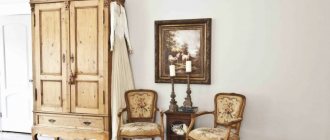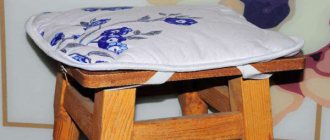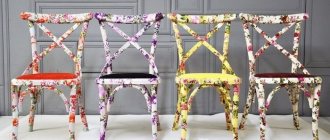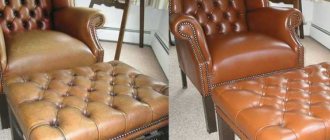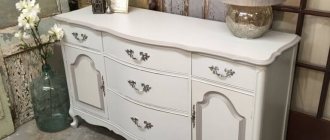Features of wicker furniture
The history of wicker furniture goes back thousands of years. Archaeologists often find it all over the world. Weaving from vines and other natural materials of plant origin was common in settlements located near bodies of water. The proximity of suitable raw materials in large quantities contributed to the fact that people made most of the products used in everyday life on their own.
Wicker furniture was used more often in the homes of the poor, as the cheapest and most accessible option. But quite quickly wealthy people and representatives of the nobility appreciated its beauty, functionality and possibilities of use in the interior. Since then, not only single craftsmen, but also entire artels, and later factories, have been engaged in weaving. There are even special schools of wicker weaving.
Prince Golitsyn brought the fashion for wicker furniture to Russia. Often traveling abroad, he appreciated the properties of wicker products and created an entire workshop for their production on his estate.
Wicker furniture can be a real work of art
Nowadays wicker furniture is very popular. Making it becomes a favorite hobby for many, even generating income. In addition, it has many advantages. These include:
- low cost, especially compared to products made from other natural materials;
- light weight, thanks to which you can easily move the furniture anywhere without outside help;
- environmental friendliness: wicker interior items not only look beautiful, but are also safe for health and do not have a specific odor;
- easy care: most often it is enough to wipe off dust from the furniture with a cloth dipped in water;
- durability, subject to high-quality weaving, performed according to all the rules.
True, there are also disadvantages that need to be taken into account. Furniture woven from wicker and similar materials is not resistant to the vagaries of the weather. In heavy rain it gets wet, and with prolonged exposure to sunlight and high temperatures it can dry out. This leads to loss of shape and disruption of the weave. Repairing a damaged product is very difficult. Therefore, it is not recommended to keep such furniture in open areas for a long time.
Nowadays wicker furniture is very popular, and many people are starting to make it at a professional level.
Types of wicker furniture
According to the structure and manufacturing principle, wicker furniture is divided into several types:
- Frameless products. In them, the rigidity of the structure is ensured by strong stick-ribs.
- Frame furniture, in which the body is made of durable material, such as steel rods. The metal parts of the frame are braided with wicker or other appropriate material.
- Wooden furniture in which the supporting frame is made of wooden sticks that impart rigidity and durability.
Pieces of furniture made of wicker or rattan - photo gallery
It is impossible to imagine a summer garden without comfortable pieces of wicker furniture
A rocking chair is the dream of anyone who loves comfort
Even a bed and an entire bedroom set can be woven from wicker or rattan
A cozy basket chair with a low base will appeal to kids and pets
A comfortable rattan hanging chair is a good place to relax after a hard day.
An airy openwork set of a sofa, armchairs and table will decorate any dining room
Video: wicker furniture made of wicker and rattan in the interior
Search for markets
The demand for do-it-yourself wicker furniture made of artificial rattan does not depend on seasonality. You can organize a business in two directions:
- select certain models of furniture and produce them for individuals, try to expand sales channels through cooperation with furniture showrooms;
- conduct an advertising campaign and work to order, fulfilling the wishes of clients.
New entrepreneurs who do DIY production still need to spend a small amount of money to attract customers. The first orders can be completed for your friends and relatives, but in the future you will need:
- advertise in local newspapers;
- post information on the Internet, on city portals, forums;
- Post advertisements around the city, leave your business cards in places where potential clients gather.
In this business, as in business, it is important to provide quality services. We need to make sure that customers are satisfied with the completed order and tell their friends about it. There are masters who do not spend a penny on advertising, while they are provided with orders through word of mouth.
When entering larger-scale production, it is necessary to enter into contracts with specialized stores that sell furniture, or organize a sales point yourself.
Advice
: An excellent option for expanding sales channels is to create your own website. By collaborating with different delivery services, you can not be limited to the domestic market and sell throughout the country or even abroad.
Save the article in 2 clicks:
The production of wicker furniture from artificial rattan is. It can develop into a profitable business that is in high demand, although the market is not sufficiently saturated with such offers and has great prospects for beginners.
Made of wood.
Today we will talk about an artificial rattan substitute (also called technorattan or polyrattan), which is used to make wicker furniture. This material is supplied in the form of multi-colored ribbons, threads, circle segments, rolled into coils. Unlike its natural counterpart, artificial rattan does not fade under the influence of ultraviolet radiation and is highly resistant to adverse weather conditions. Therefore, I often use it to make outdoor furniture or wicker decorative items that can be left outside all year round in the snow and rain.
Many owners of suburban areas would like to put furniture made of this material in a gazebo or recreation area. But the high price of these products, which are considered a “handmade” product, stops them. It was the money question that prompted the FORUMHOUSE user with the nickname Lulava
master artificial rattan weaving and all the intricacies of this craft in order to equip the living room in your house near Moscow with beautiful and functional furniture on which you can sit and relax on long winter evenings.
Lulava FORUMHOUSE Member
After searching, I found wicker furniture that I really liked.
Having caught fire with the purchase, I cooled down when I saw the price tag, but the desire to have something like that overpowered me. After studying the Internet, I made a firm decision - to start making
And here are samples of furniture that the user liked.
Now let’s announce the price tag for it: the chair costs 45 thousand rubles, the corner sofa costs 124 thousand rubles. No wonder Lulava
I ordered 26 kg of technorattan - strips 9 mm wide and 1 mm thick.
Artificial rattan is sold in kilograms. This ratio of width and thickness, as indicated above, ultimately gives the maximum length of the coil for a given weight, which allows for savings.
Also, according to the user, if you make a rattan sofa or chair with your own hands with a platform used as a self-supporting one, then it is better to use a more durable poly rattan, in the form of a circle segment, 1.2-1.4 mm thick, although artificial rattan 1 mm thick has sufficient strength and load-bearing capacity.
Work should begin with choosing a base that will be braided with rattan ribbons. One such option could be a metal frame made of galvanized or aluminum pipes. But Lulava
I settled on the most technologically advanced option - a wooden one, made from a block with a cross-section of 4x4 cm, which is then treated with antiseptic impregnations.
Rattan weaving for beginners: nuances
The most difficult thing in making artificial rattan furniture is the weaving process itself. Despite the many training videos on the Internet, it is not always possible to see the nuances of the technology. There is not enough information. Therefore, the user had to comprehend a lot by trial and error.
Start weaving rattan furniture with the simplest products. This will prevent you from “burning out” ahead of time, and also from losing interest in your work. And only after you have “filled your hand”, move on to more important subjects.
Lulava
I started the weaving work with an ottoman. Moreover, I had to redo it 3 times until I understood how to do everything correctly. Then I moved on to making the frame - the base of the sofa. To do this, I took the dimensions of the Swedish analogue - 2240 (length) x 660 (height) x 860 (width) mm.
The structure of the wooden frame is shown in the following photo.
The assembly was carried out on the “75th”, so-called. "black" screws. Although such fasteners are not the most optimal option for connecting critical structures (the heads of self-tapping screws can be cut off), the main thing is to think about how the load will be distributed.
The armrests of the sofa should not “hang” in the air. The part must rest directly on the load-bearing frame, and the main load is redistributed onto it. Self-tapping screws are needed only to fix the armrest - to connect it to the base in the desired position and prevent shifting.
When weaving artificial rattan, it is important to remember that one wrong stitch made at the very beginning will lead to a defective product. Everything will have to start over. Making polyrattan furniture is the lot of attentive and patient people.
Lulava
It is most convenient to work by placing the furniture on a stand. Even after watching the video with master classes on weaving, I still had questions about the secrets of the work. I had to learn everything from my own experience.
We will need the following tools for weaving:
- Stapler - it is necessary for fixing polyrattan strips with staples to a wooden base;
- Small pliers, with their help it is convenient to remove a bent staple;
- A light weight hammer, needed for finishing off staples;
- Knife or cutter;
- Soldering iron or superglue.
A soldering iron is needed to solder the lock - at the junction of the strips.
Practical advice on working with technorattan is interesting. We assemble the frame with maximum geometric accuracy. Misalignments or inaccuracies in measurements may result in more stitches being needed on one side than the other, or gaps remaining.
According to Lulava,
not important
- the length of the sofa, the width of the armrest, because... The pitch of the vertical threads can be changed.
But especially important
– the height of the sofa, the length of the armrest and the height of the sofa from the front side (from the seat to the bottom edge).
We carry out the weaving itself without using a shuttle, because Poly rattan is a tough material and can be pulled through rows well. Using a shuttle will only complicate the work of threading it between the strips.
Made of wood.
Today we will talk about an artificial rattan substitute (also called technorattan or polyrattan), which is used to make wicker furniture. This material is supplied in the form of multi-colored ribbons, threads, circle segments, rolled into coils. Unlike its natural counterpart, artificial rattan does not fade under the influence of ultraviolet radiation and is highly resistant to adverse weather conditions. Therefore, I often use it to make outdoor furniture or wicker decorative items that can be left outside all year round in the snow and rain.
Many owners of suburban areas would like to put furniture made of this material in a gazebo or recreation area. But the high price of these products, which are considered a “handmade” product, stops them. It was the money question that prompted the FORUMHOUSE user with the nickname Lulava
master artificial rattan weaving and all the intricacies of this craft in order to equip the living room in your house near Moscow with beautiful and functional furniture on which you can sit and relax on long winter evenings.
Lulava FORUMHOUSE Member
After searching, I found wicker furniture that I really liked.
Having caught fire with the purchase, I cooled down when I saw the price tag, but the desire to have something like that overpowered me. After studying the Internet, I made a firm decision - to start making
And here are samples of furniture that the user liked.
Now let’s announce the price tag for it: the chair costs 45 thousand rubles, the corner sofa costs 124 thousand rubles. No wonder Lulava
I ordered 26 kg of technorattan - strips 9 mm wide and 1 mm thick.
Artificial rattan is sold in kilograms. This ratio of width and thickness, as indicated above, ultimately gives the maximum length of the coil for a given weight, which allows for savings.
Also, according to the user, if you make a rattan sofa or chair with your own hands with a platform used as a self-supporting one, then it is better to use a more durable poly rattan, in the form of a circle segment, 1.2-1.4 mm thick, although artificial rattan 1 mm thick has sufficient strength and load-bearing capacity.
Work should begin with choosing a base that will be braided with rattan ribbons. One such option could be a metal frame made of galvanized or aluminum pipes. But Lulava
I settled on the most technologically advanced option - a wooden one, made from a block with a cross-section of 4x4 cm, which is then treated with antiseptic impregnations.
Rattan weaving for beginners: nuances
The most difficult thing in making artificial rattan furniture is the weaving process itself. Despite the many training videos on the Internet, it is not always possible to see the nuances of the technology. There is not enough information. Therefore, the user had to comprehend a lot by trial and error.
Start weaving rattan furniture with the simplest products. This will prevent you from “burning out” ahead of time, and also from losing interest in your work. And only after you have “filled your hand”, move on to more important subjects.
Lulava
I started the weaving work with an ottoman. Moreover, I had to redo it 3 times until I understood how to do everything correctly. Then I moved on to making the frame - the base of the sofa. To do this, I took the dimensions of the Swedish analogue - 2240 (length) x 660 (height) x 860 (width) mm.
The structure of the wooden frame is shown in the following photo.
The assembly was carried out on the “75th”, so-called. "black" screws. Although such fasteners are not the most optimal option for connecting critical structures (the heads of self-tapping screws can be cut off), the main thing is to think about how the load will be distributed.
The armrests of the sofa should not “hang” in the air. The part must rest directly on the load-bearing frame, and the main load is redistributed onto it. Self-tapping screws are needed only to fix the armrest - to connect it to the base in the desired position and prevent shifting.
When weaving artificial rattan, it is important to remember that one wrong stitch made at the very beginning will lead to a defective product. Everything will have to start over. Making polyrattan furniture is the lot of attentive and patient people.
Lulava
It is most convenient to work by placing the furniture on a stand. Even after watching the video with master classes on weaving, I still had questions about the secrets of the work. I had to learn everything from my own experience.
We will need the following tools for weaving:
- Stapler - it is necessary for fixing polyrattan strips with staples to a wooden base;
- Small pliers, with their help it is convenient to remove a bent staple;
- A light weight hammer, needed for finishing off staples;
- Knife or cutter;
- Soldering iron or superglue.
A soldering iron is needed to solder the lock - at the junction of the strips.
Practical advice on working with technorattan is interesting. We assemble the frame with maximum geometric accuracy. Misalignments or inaccuracies in measurements may result in more stitches being needed on one side than the other, or gaps remaining.
According to Lulava,
not important
- the length of the sofa, the width of the armrest, because... The pitch of the vertical threads can be changed.
But especially important
– the height of the sofa, the length of the armrest and the height of the sofa from the front side (from the seat to the bottom edge).
We carry out the weaving itself without using a shuttle, because Poly rattan is a tough material and can be pulled through rows well. Using a shuttle will only complicate the work of threading it between the strips.
Since ancient times, people have made their own household items with their own hands. Furniture was made from wood, and also woven from willow, wicker, rattan and other suitable materials. Such interior items are functional, elegant, unique, and you can make them yourself. Do-it-yourself wicker furniture made from wicker will look much more original than purchased furniture. Manufacturing will not take much time.
- 1 Life history of wicker furniture
- 2 Pros and cons of wicker furniture
- 3 Preparation for manufacturing
- 4 Types of weaving
- 5 Tools
- 6 How to weave furniture from twigs: step-by-step instructions
- 7 Product finishing
- 8 How to care for and repair wicker furniture
Tools for work
Weaving from wicker is a labor-intensive task that requires scrupulousness. You just can't do it with your hands. You will have to stock up on a whole set of tools:
- special knives and garden shears for cutting and trimming twigs;
- ladder for sorting raw materials;
- large capacity, tank for soaking the rod;
- boiler for cooking and bleaching workpieces;
- squeezers for cleaning twigs from bark;
- splitters for dividing rods into parts;
- shof for obtaining planed strips;
- shmyg for figure processing, notching;
- iser for aligning rows;
- jigs for straightening frame blanks;
- pruner;
- measuring accessories - ruler or tape measure;
- pliers;
- saw on wood.
Weaving patterns and methods
There are several ways to weave furniture and interior items. Each combines decorativeness and functionality.
Weaving patterns - table
| Name of weaving | Peculiarities | |
| Solid thick | Simple |
|
| Rope |
| |
| Checkers |
| |
| Openwork | Diamond-shaped | The weaving is complex, creating geometric shapes and open cell patterns. |
| In the form of columns | ||
| Chess | ||
| Rosette | ||
| Ring | ||
| Spiral | ||
| Pigtail | The method is used for weaving decorative elements and in the design of edges. | |
| Bending | This type of weaving is used to decorate the edges of the product. | |
Weaving methods - photo gallery
This simple weaving pattern is easy for beginners to master.
The edges of the product are often braided
Rope weaving is created from two or more rods
Openwork weaving will give the product lightness, airiness and transparency.
Using checkerboard weaving, you can decorate furniture with a three-dimensional pattern.
Finishing wicker furniture
When a chair, table, sofa or other item is ready, all that remains is to give the item a marketable appearance. Finishing work is carried out in several stages:
- Inspection for various defects, eliminating them: correct the uneven density of the weaving by slightly moving the rods, align the legs, cut off the tips of the rods and smooth out the unevenness with fine-grained sandpaper.
- Bleaching and painting. To make the product white, it is treated with lime or sulfur dioxide. To give a different color, use regular paint. They also use decoctions of onion peels, wolf berries, heather, alder bark or moss, if you like naturalness and environmental friendliness.
- Varnish coating. In order not only to preserve the texture of the material used, but also to make it even stronger, apply 2-3 layers of varnish (each subsequent after the previous one has completely dried).
Preparation for production
The process of weaving furniture cannot be called fast; preparation for it also takes a lot of time.
What can wicker furniture be made from?
To weave furniture, you can use various materials, the choice of which is limited by the climatic conditions of a particular country. The main thing is that the raw material is strong, flexible and elastic.
All material used can be divided into main and auxiliary.
For weaving you can use:
Not all of the listed materials are suitable for weaving large amounts of furniture, since they do not have sufficient strength to withstand the weight of a person.
willow vine
Traditionally, willow twigs are used for weaving, which are called a miracle material. Willow “gives” raw materials that combine flexibility and elasticity. It is these qualities that are especially valued in weaving.
Cleaned willow twigs are ready for use
There are many varieties of this tree, each with its own characteristics of use. Since ancient times, willow vines have been used for handicrafts, creating both household items and interior decoration elements. Red flower (willow), goat willow (willow), bay willow (broom), almond and other shrub species are the most suitable material for weaving.
Swamps, grass swamps, mixed forests are places where willow trees grow. Masters of their craft use them selectively - some varieties are purchased for rough weaving, others - for creating elegant little things.
Furniture made from willow wicker is very elegant
Willow vines are harvested in autumn, winter and early spring. During these periods, you can stock up on suitable twigs, since the growing season has ended in the plant.
It is difficult to remove bark from twigs harvested in autumn and winter, but material stored at the very beginning of spring (when sap flow just begins) is the best for weaving.
Additional soaking or boiling will help remove the top layer from the rods.
Branches of bird cherry, hazel, and rowan
can also be used for weaving furniture, but their use is not so widespread.
Bird cherry rods are more suitable for beginners, those who are just learning the basics of weaving. They are more pliable, easier to cut, bend and perform other manipulations when weaving.
Reed
One type of this plant material is used in weaving - lake material. Reeds that grow in the southern regions are more suitable.
Reeds are collected at the end of June - beginning of July and dried in shady places. Long thin rods 1 mm thick are made from it - peddig, which is in demand when creating “openwork” furniture elements (seat backs, decorative elements).
Reeds are stacked in sheaves for storage
Bamboo
This type of wood is very durable. For weaving, you can take whole stems or split ribbons. It bends well after treatment with an alcohol lamp. This raw material is used in the Caucasus region.
Bamboo furniture has a special pattern
Rattan
The vine, which can be found in Asian countries and the Pacific Islands, is very suitable for weaving a strong frame.
Rattan products (very popular among consumers) are most often made using a monolithic method. This technology allows rattan stems to be bent into desired configurations. Do-it-yourself rattan wicker furniture is characterized by durability and strength. An example of this is the rare Viennese chairs.
Rattan rods are dyed and bleached before use
Auxiliary materials for the frame
To ensure that wicker furniture does not fall apart the first time it is used, but lasts for many years, many craftsmen use alternative materials that add strength to such products.
Use of metal structures (frames of chairs, tables, sofas):
- helps save the consumption of basic materials;
- speeds up and facilitates the weaving process;
- adds strength to the product;
- increases the service life of furniture.
Modern life dictates its own conditions, so it is quite justified for some craftsmen to use furniture elements made of polyurethane foam, expanded polystyrene, and polyvinyl chloride. Backrests, seats and other parts in combination with wicker elements look quite organic; such furniture is also in demand on the market.
Soft upholstery will make the furniture very comfortable
When starting to prepare material, it is useful to listen to the advice of experienced specialists:
You can prepare the material yourself. If you don’t have the time or desire, you can always buy it in specialized stores.
The list of requirements that wicker weaving experts place on the material:
For weaving furniture, rods with and without bark are used: the so-called green and white rods.
The top layer is removed using a special device - a pinch.
Green twigs can be recommended for beginning dows weavers, as they are more flexible and do not require time-consuming cleaning of bark. Products made from such material do not look as beautiful as objects woven from white rod.
Cleaned rods turn white
The color of the bark-cleaned twigs can be adjusted using various means to obtain the following material:
- snow-white (hydrogen peroxide);
- brown (potassium permanganate solution);
- grayish (iron sulfate):
- different shades (aniline dyes).
Caring for wicker and rattan products
Wicker furniture requires special care, which is due to the characteristics of the material used: wicker and rattan can become very fragile if not used correctly.
- At least once a week, wipe off dust from products with a damp cloth.
- If a large amount of water gets on wicker furniture, first wipe thoroughly with a dry cloth, then take it out into the air to allow the product to dry naturally. Do this immediately.
- Vacuum wicker items only using soft attachments.
- If you notice that the braid has begun to dry out, spray it with linseed oil from a spray bottle.
- To protect wicker furniture from moisture, treat it with tung oil or tung-based products twice a year. Do this at the beginning of the season (before moving furniture outside) and at the end.
To protect wicker furniture from high humidity, treat it with tung oil-based products.
Wicker furniture is a rather difficult product to repair. In the event of a breakdown, it is difficult to find a repairman who will undertake the repair. Therefore, proper care is mandatory and necessary for products made from wicker and rattan.
What is artificial rattan?
Rattan is a polymer thread that is produced by extrusion. The plastic is melted to a certain temperature, then passed through a specialized mold. Depending on the type and nozzle of this shape, it is possible to obtain a synthetic thread in the form of a rod, a crescent, an imitation of wooden bark and much more. The result is raw material for further weaving of different textures and colors. The plastic components must meet all specified criteria and ISO 9001 standards, be pleasant to the touch and odorless.
Features and advantages of artificial rattan:
- aesthetic appeal;
- high degree of material strength;
- moisture resistance;
- lightness of the material, which makes it easy to move around the house and during transportation;
- ease of assembly;
- duration of operation;
- does not require special care - just wipe with a damp cloth to remove dirt.
Rattan has many advantages for manufacturers as well. It is easy to work with the resulting raw material (plastic thread); due to the flexibility of the material, you can make products of any shape, even extraordinary ones (which is now popular in the interior design of houses). In addition, rattan plastic thread is very long (some manufacturers produce it up to 200 meters), so it is easy to work with. And you don’t need to think about connecting the lashes, which is important for natural materials.
